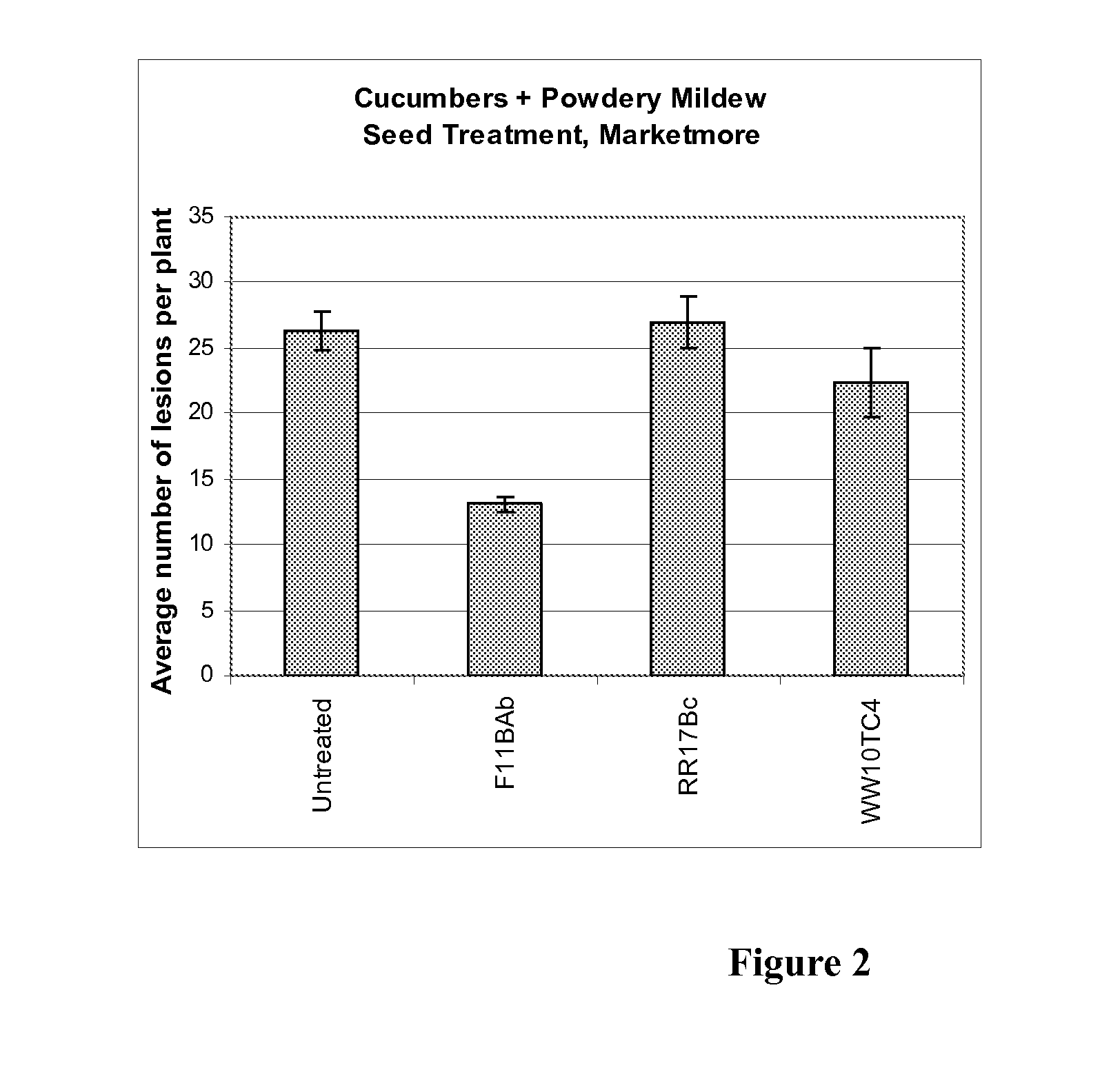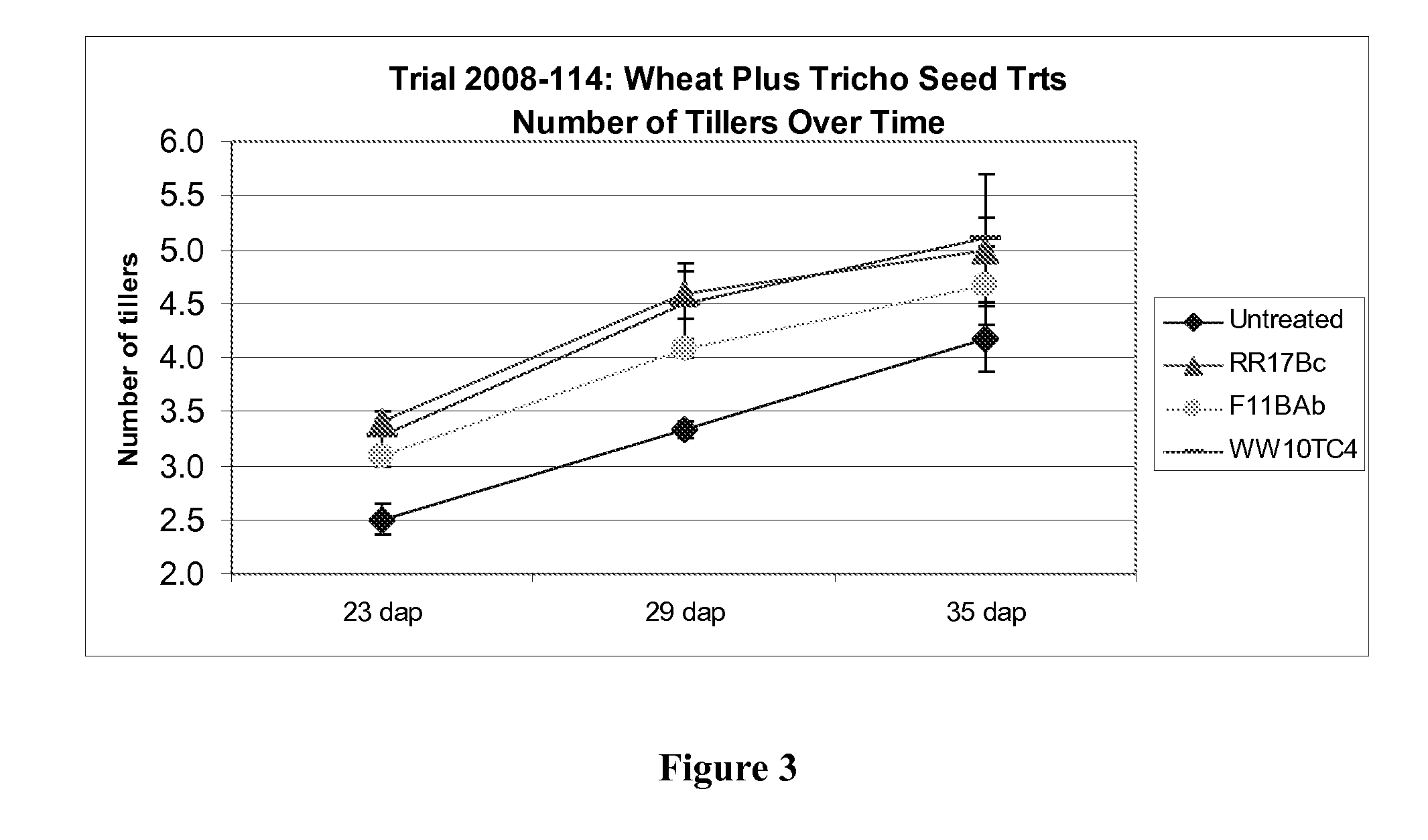Trichoderma strains that induce resistance to plant diseases and/or increase plant growth
a technology of trichoderma and plant diseases, applied in the field of trichoderma strains, can solve the problems of reducing reducing the number of plants, so as to increase the yield of plants, increase the root mass and depth of rooting, and increase the effect of plant yield
- Summary
- Abstract
- Description
- Claims
- Application Information
AI Technical Summary
Benefits of technology
Problems solved by technology
Method used
Image
Examples
example 1
Rhizosphere Competence and Enhanced Root Development
[0063]The revolution that has occurred in the understanding of Trichoderma-plant interactions has led to screening systems for identification of better and improved strains with desirable properties. There could be several criteria for selection of better strains, for example, the identification of rhizosphere competence. Rhizosphere competence can be defined as the abilities of strains to efficiently colonize roots, to grow with and to colonize the entire root system. This permits long-term, at least season long, effects on plants.
[0064]Rhizosphere competence can readily be assessed, for example, by the methods described in Sivan et al. “Improved Rhizosphere Competence in a Protoplast Fusion Progeny of Trichoderma harzianum,” J. Gen. Microbiol. 137:23-29 (1991), which is hereby incorporated by reference in its entirety. For the purposes of the present invention, rhizosphere competence can be assessed by the following method: seeds...
example 2
Selection of Improved Strains
[0067]Various strains of Trichoderma were selected and tested for rhizosphere competence. All of the strains described in the present application were prepared with a process of asexual hybridization using protoplast fusion (Stasz et al., “Non-parental Progeny Resulting from Protoplast Fusion in Trichoderma in the Absence of Parasexuality,”Exp. Mycol. 14:145-159 (1990), which is hereby incorporated by reference in its entirety). To ensure rhizosphere competence, the distal root isolation procedure, as described in Example 1, was used to identify subisolates. As noted elsewhere, these have some instability and are sectored. Several different sectors were isolated and tested. The number system for the strains is important. The first letter or letters indicates the specific protoplast fusion that was conducted and the number immediately following described the order in which the specific progeny was picked. Each different set of letters indicates a differen...
example 3
Increase in Growth of Wheat
[0074]Increased biomass of wheat may be expressed as numbers of tillers (also known as side shoots) that are produced. As the wheat plant grows, it forms tillers that each provides an additional head of grain. Thus, for example, if the wheat plant sequesters more carbon, this ought to be expressed as additional tillering. These experiments, which measured the number of tillers (FIG. 3), were conducted in a greenhouse using seeds of spring wheat variety Glenn which were treated following the protocol described in Example 1. Assuming that tiller lengths are similar across treatments, the total cumulative tiller length ought to be greater in strains that increase tiller number. This data is shown in FIG. 4. Data is shown with the standard deviation. As can be seen, all of the strains tested increased total tiller length relative to the control.
[0075]Data obtained shows that the three strains increase yield and tillering in wheat. These data indicate that (a) ...
PUM
| Property | Measurement | Unit |
|---|---|---|
| weight | aaaaa | aaaaa |
| length | aaaaa | aaaaa |
| volume | aaaaa | aaaaa |
Abstract
Description
Claims
Application Information
 Login to View More
Login to View More - R&D
- Intellectual Property
- Life Sciences
- Materials
- Tech Scout
- Unparalleled Data Quality
- Higher Quality Content
- 60% Fewer Hallucinations
Browse by: Latest US Patents, China's latest patents, Technical Efficacy Thesaurus, Application Domain, Technology Topic, Popular Technical Reports.
© 2025 PatSnap. All rights reserved.Legal|Privacy policy|Modern Slavery Act Transparency Statement|Sitemap|About US| Contact US: help@patsnap.com



